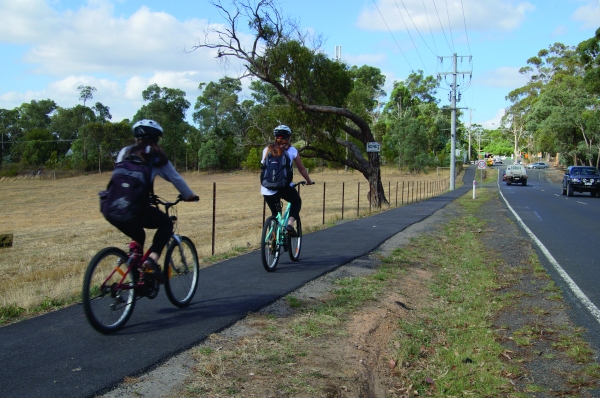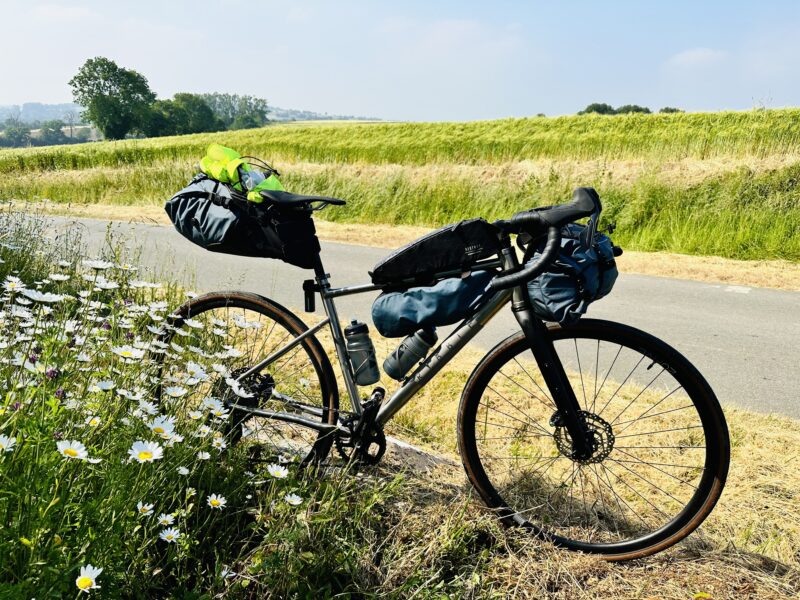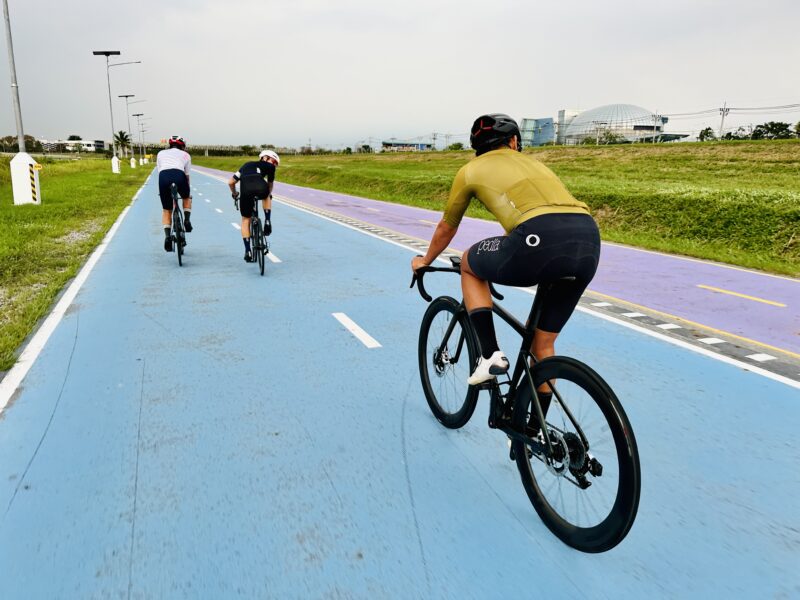Teens in traffic
Should teenagers ride on the road? Simon Vincett takes a look at why those 12 years and older should be able to ride on the footpath.

Hobart’s Emma Pharo is the mum of two active teenage boys. They love riding their bikes to school or to friends’ houses in their downtime. Pharo is relaxed about letting her boys, aged 14 and 12, ride regularly because they’re able to stay off the roads and ride on footpaths on their journeys.
Tasmania’s road regulations allow anyone to ride on footpaths (unless signed as ‘No cycling’), unlike the regulations in Victoria, New South Wales, South Australia and Western Australia, which don’t allow children over the age of 11 to ride on the footpath. “As a parent I really like to be able to tell my 14-year-old that he should use the footpath in a couple of tricky spots between home and school or home and his friends’ houses. I worry less about him knowing that he can use the footpath if he has to,” Pharo says.
Pharo believes Tasmania allows teenagers to ride as often as possible. It allows them to learn some of the skills they’ll be able to use when they feel confident enough to ride on the road, like watching for oncoming obstacles or other traffic. Pharo is also the Facilities Development officer for Bicycle Tasmania, so she is well-versed in catering for bike riders. “Our cities are yet to be retrofitted with good bike infrastructure,” she explains. “In the meantime it would be a big deterrent to less confident riders if they could not use the footpath.”
As parents of teens know, the phase of growth from 12-16 years old is as rapid and intense a transformation as toddlerhood (from one to three-years-old) and, like toddlers, it’s similarly hard to determine an adolescent’s level of ability with many tasks. While teenagers may seem to transform into adults as the onset of puberty spurs rapid growth and body changes, it’s a mistake to assume that they have gained adult capabilities.
“Riding a bicycle involves the simultaneous execution of motor skills and cognitive skills,” explains a bicycle education guide prepared for the US Department of Transportation. Bicycle safety education for children from a developmental and learning perspective gathers research into the abilities of children at different ages to provide bike ed that is age appropriate and ability appropriate. Motor skills are the essential balance, pedalling and braking actions but also include turning the head to scan while riding, indicating to turn while riding and accelerating into a gap in traffic. The necessary cognitive skills are the spatial and temporal abilities allowing them to choose gaps in traffic, and the ability to ignore distractions in order to negotiate traffic situations.
Our cities are yet to be retro-fitted with good bike infrastructure… In the meantime it would be a big deterrent to less confident riders if they could not use the footpath.
The guide continues: “While children are able to perform two tasks at once, they often sacrifice cognitive performance for motor skill performance. Research suggests children begin to handle dual-tasks like adults, where they show some decrement in both tasks but good performance overall, during adolescence.”
It is during this period of mastering these skills that the response time of adolescents improves, the guide explains. “Children have slower response times that gradually improve with age and are adult-like by approximately 14 years old. This means that children have a delay from the moment they make their decision to the moment they begin to act on their decision.”
For Warren Cann, psychologist and Chief Executive Officer of the Parenting Research Centre, the most significant issue with adolescents on the road are some critical thinking errors to which they are prone. “The two thinking errors that are relevant here,” says Cann, “are a sense of invulnerability and underestimating risk. Both of those things have implications. It means that, especially young teenagers, while they might have the cognitive capability there are issues about judgement that leave them at risk riding on the road. At a theoretical level they can be conscious that they are in fact not immortal but they are prone to acting as if they are, as if they are bullet-proof. They have an under-lying assumption that bad things happen but they don’t happen to me, making assessments such as ‘I can squeeze into that gap’ likely.
This risk-taking, or sensation-seeking, behaviour in adolescents is a topic tackled by the World Health Organisation in its 2007 publication Youth and Road Safety.
“Risk-taking behaviour may allow adolescents to feel a sense of control over their lives or sometimes to oppose authority. Research shows that there are high levels of ‘sensation seeking’ behaviour among young adults and a need to maintain a heightened level of physiological arousal. Young people consequently seek new situations and experiences to maintain this level, irrespective of the risks inherent in the experience. Such sensation-seeking frequently focuses on risky behaviours, including while driving a vehicle or crossing a road. Sensation-seeking has been shown to rise between the ages of 9 and 14 years, peaking in late adolescence or the early 20s, and then declining steadily with age. Across all ages and particularly among the young, sensation seeking is more common among males than females.”
The WHO publication goes on to trace the source of influence. “As young children become adolescents, peer influence becomes increasingly important, compared to the earlier strong influence of parents. For many young people, their peers are the most important people in their lives and are often also their primary source of behavioural norms. Teenagers can be led by what is considered “cool”, not necessarily what is safe.”
To tackle the issues of thinking errors and peer pressure, practice under parental supervision in earlier years provides the best foundation for adolescents to ride competently on their own, according to Warren Cann. “Experience is the thing that really does matter, lots of experience. Where the risk really lies is in the unusual. They’ve got to be able to handle themselves when a problem comes up, not just in the normal when things are going really well. So you want to have experience in all sorts of conditions before the child goes out riding by themselves.”
The findings of a literature review for the Queensland Department of Transport concerning the hazard perception abilities of novice drivers backs Cann’s suggestion. “Hazard perception… requires scanning of the environment, evaluating the relative location of other road users and predicting their behaviour. More experienced drivers are able to detect hazards faster. A deficit in hazard perception skills has been associated with increased crash rates, even when age and driving exposure (distance travelled) are statistically controlled. Hazard perception skills are closely linked with situational awareness, attentional control, time sharing and self-calibration skills (moderating behaviour to match the difficulty of the driving situation with the driver’s level of skill).”
In Queensland, where footpath riding is permitted for all ages, governments use the footpath space for pragmatic solutions to difficult traffic situations. Ben Wilson, Chief Executive Officer of Bicycle Queensland, has praise for councils such as Brisbane City Council for pro-actively using the footpath in this way to traverse challenging intersections.
“Councils provide a ‘cut through’ with a pram-ramp-type modification to the kerb at 45 degrees in favour of the bike so that the bike can duck up on the footpath and come back onto the road,” Wilson reports. “There are a handful of these around but they are very helpful and welcome for riders.”
Wilson believes footpath riding in Queensland is a great facilitator of riding, for the refuge it provides. An obvious user is a rider who chooses to do the bulk of their riding on an off-road path. “They like the fact that when they get to the city and get off the bike path for the first time and they’re on the road they can use the footpath to get to work and to where they are going,” he says.
Considering a situation of footpath riding being disallowed, another instance occurs to Wilson: “The mum who doesn’t like riding on the road: she rides the kids to school but how does she get home? It’s cleaner to have the law clear that anyone can ride on the footpath. You can ride with your kids to school and when you turn around to come home you can ride on the footpath as well.”
A common objection against allowing bike riders on the footpath is a fear of collisions with pedestrians. Wilson says complaints about conflict between bikes and pedestrians are not a significant concern. “There’s actually quite little,” says Wilson. “For instance with the cut throughs, people treat it very sensibly. We’ve got no reports of complaints.”
I think bike riders are well aware that they need to give way to pedestrians and the sort of people who are riding on footpaths are going slowly.
Councils have the capability to post “No cycling” signs to prohibit footpath riding in areas but Wilson reports that not many take that step. “In Brisbane there are virtually no ‘No cycling’ signs anywhere, except on private property and the Mall [the pedestrian-only retail centre of the city].”
Emma Pharo says it’s a similar situation in Tasmania—the conflict is simply not a problem. “For us … having adults and older children riding on the footpath is a non-issue, and I’m very aware of the things that annoy people about cyclists in Tasmania and this is a non-issue.”
“I think bike riders are well aware that they need to give way to pedestrians and the sort of people who are riding on footpaths are going slowly,” Pharo reasons. “Even myself, when I’m using the footpath in areas where I don’t want to be on the road, I ride slowly and I take care. It’s really nice to have that option to keep the stress levels down because you’re not having to ride close to fast moving traffic.”
Ben Wilson thinks the Queensland experience has illuminated amenity of the vital space of the footpath. “It has brought into perspective footpath design. We’ve always argued for wider footpaths. The standard one metre is awful. We think they should be two metres, so that two people pushing prams, two wheelchairs, can pass each other. Very slowly we’ve seen improvement. The standard now is 1.2 metres. The standard around schools is two metres. We’ve had a few wins where footpaths are widened to be more accommodating.”
But widening footpaths is not enough according to Ben Rossiter of Victoria Walks, Australia’s premier walking advocacy organisation. He believes that bike riders on the footpath will prevent people from walking, which he cites as “the most common, popular form of physical activity”. Any reduction of activity is to the detriment of public health but a threatening environment on the footpath is a debilitating obstacle for the walking dependent.
“The walking dependent,” explains Rossiter, “are seniors, people with vision impairment and other disabilities and children. These are people who have fewer other options for transport. We need to be designing our streets and suburbs to enable them to walk.”
Rossiter contends that seniors, for instance, are already faced with unreasonable risk in the current traffic environment. “Seniors are well overrepresented in the crash stats. Our approach to road safety is to tell seniors to take extra care. We need to create road environments that take better care of them. We really need to be designing our community around the 8 to 80 principles. If you do that you’re designing for everyone.
“In that ideal model the bike rider should be on the road. Footpaths are for feet. They’re for walking, but they’re also for talking, for playing, for living, for learning, they are the basis of our public and community space. They need to be protected and strengthened. “Where walking and cycling intersect is around the issue of speed. If we have slower urban speeds, footpaths can be for walking and playing and our road network is going to be safer for cyclists.
“Seniors are overwhelmingly concerned with not falling. In OECD countries about 74% of serious pedestrian injuries and fatalities are from slips, trips and falls. So they’re watching where they are walking. Things which surprise them are a real concern. With hearing and vision dropping they don’t see a bike coming. Their concern is a bike whizzing behind them, not ringing the bell. That is more of a barrier than actual collision. The perceptions are really critical for seniors.”
Rossiter’s arguments are not new ones but there is currently no research giving a definitive answer as to whether allowing more teens ride on the footpaths increases the risk of crashes between pedestrians and bike riders.
As an Abstract in 2011 from the Australiasian College of Road Safety Conference, entitled Pedestrian–Cyclist Collisions, Issues and Risks states: “[Monash University Accident Research Centre researcher Alan] Drummond concluded in his report that the problem of casualties due to collisions between cyclists and pedestrians on footpaths was of very small proportions such that it need not be considered in the formulation of policy. Moreover, a report on Pedestrian and Cyclists Safety from the Legislative Assembly of Queensland (1993) concluded that collisions with motor vehicles caused the vast majority of cyclist deaths and injuries.”
The Queensland experience points to the fact that footpath riding is not without its risks for the bike rider as well. Conflict with driveways is a problem “particularly on hills,” says Ben Wilson of Bicycle Queensland. “We’ve got one or two instances where a footpath has been upgraded deliberately or in a surrogate way it’s become a bikeway, down to the point that it’s become listed on the council’s bikeway map.”
“We’ve had police and community meetings about how to deal with Galloway’s Hill on Wynnum Road. It’s a screaming downhill where bikes do go too quick and sometimes cars back out unknowingly and we have accidents.”
An earlier study by Monash University in 1988, commissioned by the Road Traffic Authority, found that 14% of nonriding teenagers surveyed said they would start riding if it was legal to ride on the footpath. The study recommended “a trial of legalised footpath cycling in a limited area of metropolitan Melbourne in order to collect the information required to more confidently predict the safety outcomes of legalised footpath cycling.”
The special amendment to the road regulations in these two specific locations required riders to give pedestrians right of way and travel ‘slowly enough to be able to avoid colliding with pedestrians and vehicles using driveways.’
This recommendation was realised with a year-long trial in middle-Melbourne suburb of Nunawading and the central Victorian town of Shepparton, November 1991 to November 1992. The special amendment to the road regulations in these two specific locations required riders to give pedestrians right of way and travel “slowly enough to be able to avoid colliding with pedestrians and vehicles using driveways”. It also forbade riders from “entering the road from the footpath without stopping”.
Assessment of the Nunawading and Shepparton footpath cycling trials was undertaken via phone surveys of 796 residents in the Nunawading area and 822 residents of Shepparton.
“Respondents [in Nunawading] who believe that cyclists should legally be allowed on the cycle on the footpath (54% vs 34% in Shepparton) provided the following major explanations [which are very similar to the explanations given in Shepparton]:
- It’s safer—less dangerous
- Too much traffic on the roads
- Young cyclists have little road sense
- Motorists don’t give cyclists any consideration
- Footpaths are wider.”
“By way of contrast, sample members [in Nunawading] who reject the suggestion that cyclists should legally be allowed to cycle on the footpath (35% of the total sample) provided the following major reasons[which are very similar to the reasons given in Shepparton]:
- Dangerous for pedestrians, elderly and young people
- Footpaths are for pedestrians
- Cars back out of driveways, dangerous for cyclists
- Not enough room—too narrow
- No respect for pedestrians
- Young people are irresponsible, reckless.”
However, “13% of pedestrians (7% in the Shepparton study) would take up cycling if it were legal to ride on the footpath; this ranges from a high of 19% in the youngest age group (18–30) to a low of 2% in the over 60s.”
The Shepparton trial report also provided an insight into who is using the footpath on their bike. “Exactly half of all cyclists ever ride along the footpath; younger respondents are much more likely to do so than the over 18s (14–17: 63%). However, it is also clear that riding on the footpath is not a particularly frequent occurrence (‘Not very often’ and ‘Sometimes’: 73%).
Respondents told researchers “The key reasons for cycling on the footpath [in both Nunawading and Shepparton] centre around safety perceptions:
- Safer—not as dangerous
- Less traffic—too much traffic on the road
- More space on the footpath—wider
- Smoother ride—less bumpy
- Can supervise children
While safety is front of mind for parents and students, for Craig Richards, CEO of Bicycle Network, it’s also about getting teens physically active. Mr Richards is calling for the age to ride on footpaths in Victoria, New South Wales, South Australia and Western Australia to be raised to 16. “We want all teens to have the skills to ride on the road, but they need to learn them first. Allowing them to ride on footpaths, whether they’re doing it for the first time or they’ve done it before during their primary school years, means they can learn them in an environment with far less traffic. This is an awesome way to get them to be confident riders who can handle riding on the road. It’s also a way to keep encouraging them to stay active.”
The key activity opportunity is to get these kids riding to school, Richards contends, “Children gain enormous health benefits from riding to school—it means they are getting regular physical activity every day (the recommendation is children get 60 minutes of physical activity every day). Research shows regular exercise like riding not only decreases the risk of developing preventable diseases like Type 2 diabetes and some cancers, it also improves mental health and concentration in class meaning children become better learners.”
Emma Pharo agrees—for her and her sons the footpath is a very welcome refuge when it’s available. “I am a confident, fit rider who is very happy in traffic and I use footpaths all the time just to keep out of the way of cars,” Pharo says.
“I think more people ride if they can use the footpath,” says Pharo. “It gives people who are less confident a chance to negotiate the streets. I see quite a few people, particularly older kids and women, using the footpath because it gives them an option rather than riding on busy roads.”
Bicycle network is campaigning to have the legal age for riding on footpaths raised to 16 Australia-wide. Find out more about the campaign and how to get involved.
Ride On content is editorially independent, but is supported financially by members of Bicycle Network. If you enjoy our articles and want to support the future publication of high-quality content, please consider helping out by becoming a member.








At 64 years old, I am not a teenager, but I do commute to work by bicycle. For me the most dangerous and easily rectified road configuration, is the periodic islands down the middle of the road – supposedly pedestrian refuges. Without such islands, cars and buses can easily and safely overtake cyclists, however when such islands are present, cars have to pass dangerously close to cyclists. It is a nightmare when buses overtake – and they do, almost brushing your handlebar!
If you could convince local authorities to reverse this popular trend of putting islands down the middle of arterials, it would be a big win for cyclists safety.
The 1m law is well needed to hopefully bring some sense to some people, and especially Bus drivers who tend to leave space at the front, but when they go left again the backside push you of the road. There is at least 1 idiot bus driver on Ridge Rd (Mt Dandenong) who keeps driving like a maniac and brushes within 20cm. I will get him on camera soon.
Geert, if you read this, I wouldn’t wait for photos of such dangerous actions. Firstly, I suggest you report the action to police. Then to the relevant workplace safety authority- citing that the bus driver is driving for work, therefore it is a workplace safety matter, and his the drivers’ employer – unless he is self-employed – has a clear responsibility to deal with unsafe actions by their employee. Thirdly I would contact the employer (again if there is one), and inform them of the actions of their driver, and of the reports you have made.
In each case, clearly ask what the police/workplace safety authority/employer intend to do. If you can, get everything in writing/email/text, including their responses.
It is highly likely you are not the only victim of this reckless person.
If you don’t get satisfactory responses from those you report it to, keep on up the chain of authority, then put in in the media.
Hope that helps
I agree David. Island refuges would have to be the worst piece of road infrastructure ever invented. Why would you want to encourage people to stand in the middle or off the edge of a footpath where they are more likely to be hit by traffic. They are also the bane of cyclists, where one cannot keep a straight line even if you wanted to. They also impede traffic flow. Get rid of them now.
One of the fundamnetal problems with road safety approaches is that something that is done to intentionally assist with one safety issue – in this case traffic islands- can often create or exacerbate a problem on another issue, or for other road users (in this case, bicyclists)
Not sure if there is ‘an answer’ in these cases unfortunately
Did not realise we had such a large discrepancy on age limits! Great argument to call for consistency for all Australia. Minimise confusion. Plus also make it easier for kids to continue to ride through most of their school years. This would certainly help those less confident, and it would also not impact those very confident who are happy to ride on the road.
Busses
that wasn’t the topic here.
Kids on the road. should they be kicked of the footpath at 12? i say no. A factor in staying safe on the road is getting your speed up. kids don’t ride straight and clean yet alone do it at 40+ km/h down the road.
As an adult I use the footpath as a safer option when i am riding my mountain bike on the weekend ride with the wife.
All bike riders should have the option of using the footpath. but maybe with a 20km/h speed limit so as to have room for pedestrians as well. and this 20Km/H should be the speed for any shared path. I am not meaning off road bike paths that are used by pedestrians here.. tell them off they have there own path near by.
I have to ride in some places briefly along a footpath because it is too dangerous to stay on the road….. Places where the road is very narrow and traffic is fast or very congested are not bike friendly so surely common sense allows us to deviate on to a footpath, at a safe speed, until conditions allow us back on the road. Joggers can legally run on a footpath and they go at up to 15kmh, the elderly in their gophers I have seen going faster and the driveway entry exit speeds are about 10kmh. So it doesn’t matter how old you are, you should be allowed to ride on the footpath at a safe designated speed.
As per my earlier comment about transferring problems, riding on footpaths can reduce on-road risk between cyclists and motor vehicles – but it can creat new ones between cyclists and pedestrians. It shouldn’t in theory, but having been pushed off the footpath almost into the path of traffic trying to avoid a reckless bicycle courier in wet weather, assures me the theory doesn’t work so well in practice (and from various other case studies).
We do need a strategy of some kind, and associated actions to try and reduce the unsafe riding of bicycles by young people on footpaths (not all young people, and not always).
That’s ain’t going to be easy, but it is necessary. I get young teenagers to stop riding their bicycles/scooters into buildings every week during my your programs. They acknowledge that they understand why not, but 2 hrs later, they ride them out of the building! I am sure most parents understand how that all works!.
City of Stirling WA in their Bike Strategy did a review of bike infrastructure. Although adults and over 10s can’t ride on paths, adults can ride with an under 10, etc, their legal advice was that there are so many other anomalies about path use for bikes and posties that in reality the law is meaningless. Consequently the City should insure itself for any bikes on any paths, ie, City liability risk mgt. Their Strategy then goes on to say that based on that they recommend all Paths should lawfully permit riders, but with a speed limit comparable with that required of Posties.
I also checked with the 3 Metro Police areas to see what they think. Two of them say, there are so many roads that are unsafe for cyclist to use, that they permit adults to ride on all paths, as they do themselves, ie, there a number of roads they too wouldn’t use while commuting or using on duty on a bike. The 3rd area wouldn’t comment. However, if they see unsafe behaviour they use the law to help them deal with such situations.
It’s ridiculous that children, who are deemed not suitable to hold a driver’s licence, are required by law to ride on the road. They don’t know the road laws, and nor should they be required to. It’s little wonder that our society is becoming fatter, we have made it almost impossible for our teenage kids to get around town without the aid of a motorized vehicle. On top of that, not many parents let their kids ride to school as they perceive riding on the road to be too dangerous – the result of which is more parents driving their kids to school, thereby exacerbating the problem!!
I agree with raising the age with a proviso that schools be required to have at least one bike ed session annually. A friend was backing slowly out of her driveway recently and beeped on her way out whilst unable to see the footpath due to the fence. A teenaged girl with headphones on ran into her car causing damage to the car. The girl’s parents visited and were very angry with my friend. Who is to blame? It is essential that riders know that they are responsible for riding safely at a reduced speed when they are on the footpath.
I’m currently living in Victoria and I think the law here should be changed. Some road are just not designs or equipped to have bicycles Rodin along side of cars. I’ve done 5 great Victorian bike rides (an organised event with police patrols and all) so I do have some experience as a rider. To this day I still use footpaths if I do not feel safe riding on a particular road, I’m not going to put my self in the line of fire if the road I have to talk has no bike lane. For example; there is only one road out of where I live and it has no bike lane or shoulder, trucks are barrelling down the road at 70+ km/h. What are the cops going to say if you talk about safety? They can’t deny your safety precautions.
So yes, if you feel unsafe riding on a road with no shoulder or bicycle lane, I suggest using the footpath because I know I will continue to use it if I seem a road unfit for riding. Thanks for reading my long comment